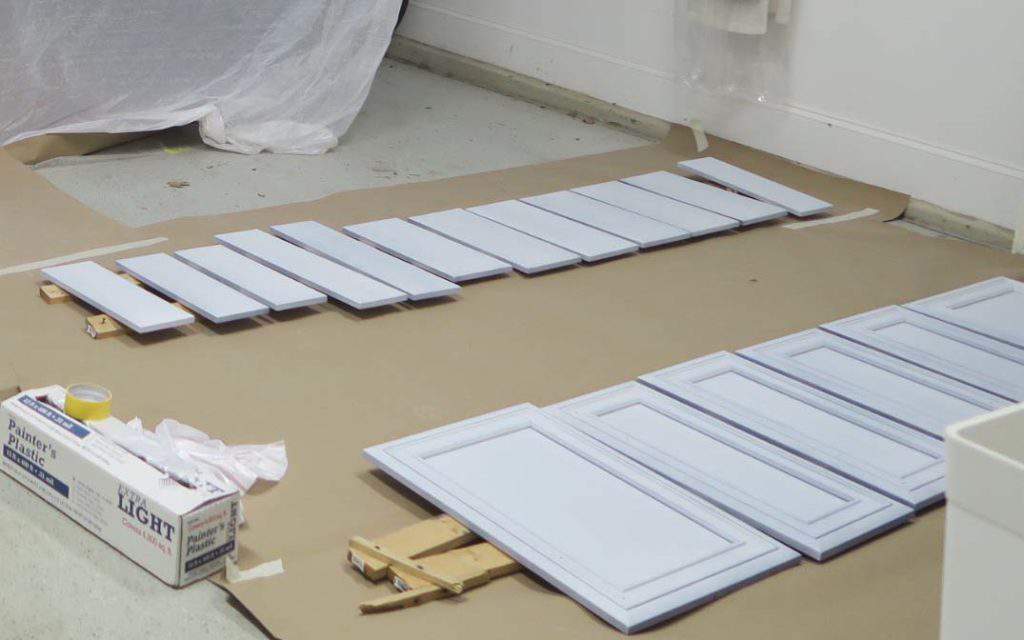If it solidifies totally, sand it smooth. Sand all surfaces with the grain using 100-grit paper. To make certain no bits of dust mar the surface, vacuum the cabinets inside and out, then rub them down with a tack cloth to catch any debris that the vacuum misses out on. Dee says, "Hand sanding is the very best method on oak due to the fact that you can press the paper into the open grain, which a power sander or sanding block will miss out on. Cabinet Painting Charlotte NC." When utilizing a tack cloth, unfold each new cloth totally, down to one layer, then fold it to get the best dust collection surface.
However they just sink into open-grained woods such as oak, ash, mahogany, or hickory. Brushing putty, the pudding-thick, oil-based finish Dee used on these oak cabinets, fills the grain as it primes the wood. A couple of caveats: It must be applied with a good-quality nylon-polyester brush, which you'll have to get rid of after each coat.

Beginning at the top of the cabinet, brush on the guide or brushing putty across the grain, then "tip off" pass the brush gently over the wet finish in the instructions of the grain (Cabinet Painters 28208). Constantly tip off in a single stroke from one end to the other. Give it a day to dry.

Sand any profiled surfaces with a medium-grit sanding sponge. When you're done, everything must be glass-smooth. Follow the underlying structure of the cabinet or door with the brush. Where a rail (horizontal piece) butts into a stile (vertical piece), for example, paint the rail first, overlapping somewhat onto the stile.
The Main Principles Of Best Type Cabinet Painters 28215 Of Roller For Painting Cabinets (Quick Guide ...
Where a stile butts into a rail, paint the stile initially. Squeeze a thin bead of latex caulk into any open seams. Pull the idea as you go, then smooth the caulk with a moist finger. Fill any small dents, scratches, or dings with vinyl spackle, smoothed flat with a putty knife.
Spot-prime the spackle, and any areas where the brushed-on primer is "burned through," with a spray can of fast-drying oil-based guide. Wait an hour, then sand the primer gently with 280-grit paper. Vacuum all surface areas, and wipe with a tack fabric. The hole in a caulk tube's pointer ought to be no bigger than the suggestion of a sharp pencil.
Work from top to bottom, using the paint across the grain, then tipping it off with the grain. For cabinet interiors, use the paint with a smooth-surface mini roller, which leaves a small orange-peel texture. Sand all surface areas with 280-grit paper, then vacuum and tidy with tack cloth. Cabinet Painting Contractors 28212. For the last coat, break out a new brush.
Brushes get dust, so always put paint into a different container to avoid contamination of the paint in the can. If any paint is left over, put it back into the can just through a fine-mesh strainer. The method for prepping and painting doors, drawers, and shelves is the exact same as on the cabinets, except that all the work is done on a table to reduce the opportunity of drips, runs, and sags. Cabinet Painters 28210.
The Best Guide To A Painting Trick To Cover Brush Marks - Apartment Therapy
Follow the same prep sequence when it comes to cabinetsclean with deglosser, fill the holes, sand, vac, and tackand the same priming sequence: in this case, 2 coats of brushing putty. Smooth the flat surface areas on the panel and the frame with a random-orbit sander. On bevels or profiles, apply elbow grease and a medium-grit sanding sponge.

When priming or painting paneled doors, brush in the following sequence to get the best-looking surface area in the least quantity of time: begin with the location around the panel, then do the main field of the panel, then complete with the stiles and rails around the edges. As you go, clean up any paint that winds up on adjacent dry surfaces. Cabinet Painters 28214.

After vacuuming and adding all the surface areas, spray a fast-dry guide on any spots with spackle or bare wood where the sandpaper "burned through" the primer. Wait an hour before sanding - Cabinet Painters 28211. Eliminate all dustfirst with a vacuum, then with a tack clothand use the surface coat. Pointer it off with the grain.
Vacuum and tack every piece, then brush on the final coat. To prevent drips on outside edges, pull the brush towards them. To prevent drips in corners, initially dump the brush by removing the paint, then paint by pulling the brush away from the corner. If a drip laps onto a dry surface, wipe it up right away.
See This Report on Nuvo Titanium Infusion 1 Day Cabinet Makeover Kit - Amazon ...
John Dee, a perfectionist, chooses to do one side at a time, keeping the faces flat so they do not get runs. But that's 2 days of drying time per doorone day per side. Here's his technique for painting both sides in a day. Twist two screw hooks into holes drilled in an unnoticeable door edge (the lower edge for bottom cabinets, the upper edge for leading cabinets).